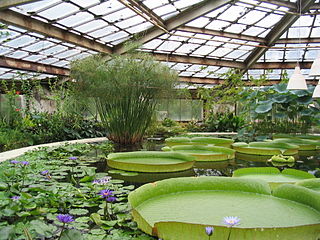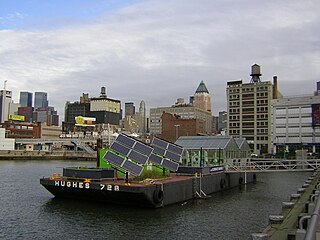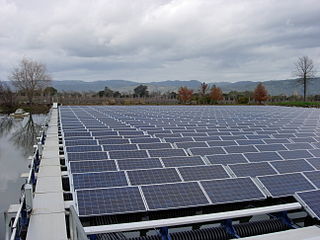Related Research Articles

Hydroponics is a type of horticulture and a subset of hydroculture which involves growing plants, usually crops or medicinal plants, without soil, by using water-based mineral nutrient solutions in an artificial environment. Terrestrial or aquatic plants may grow freely with their roots exposed to the nutritious liquid or the roots may be mechanically supported by an inert medium such as perlite, gravel, or other substrates.

Solar energy is radiant light and heat from the Sun that is harnessed using a range of technologies such as solar power to generate electricity, solar thermal energy, and solar architecture. It is an essential source of renewable energy, and its technologies are broadly characterized as either passive solar or active solar depending on how they capture and distribute solar energy or convert it into solar power. Active solar techniques include the use of photovoltaic systems, concentrated solar power, and solar water heating to harness the energy. Passive solar techniques include orienting a building to the Sun, selecting materials with favorable thermal mass or light-dispersing properties, and designing spaces that naturally circulate air.

A greenhouse is a special structure that is designed to regulate the temperature and humidity of the environment inside. There are different types of greenhouses, but they all have large areas covered with transparent materials that capture sunlight and heat. The most common materials used in modern greenhouses for walls and roofs are rigid plastic made of polycarbonate, plastic film made of polyethylene, or glass panes. When the inside of a greenhouse is exposed to sunlight, the temperature increases, providing a sheltered environment for plants to grow even in cold weather.

Aquaponics is a food production system that couples aquaculture with hydroponics whereby the nutrient-rich aquaculture water is fed to hydroponically grown plants.

An Earthship is a style of architecture developed in the late 20th century to early 21st century by architect Michael Reynolds. Earthships are designed to behave as passive solar earth shelters made of both natural and upcycled materials such as earth-packed tires. Earthships may feature a variety of amenities and aesthetics, and are designed to withstand the extreme temperatures of a desert, managing to stay close to 70 °F (21 °C) regardless of outside weather conditions. Earthship communities were originally built in the desert of northern New Mexico, near the Rio Grande, and the style has spread to small pockets of communities around the globe, in some cases in spite of legal opposition to its construction and adoption.

The Stadio Marcantonio Bentegodi is a stadium in Verona, Italy. It is the home of Hellas Verona of Serie A and was also the home of Chievo Verona, a former football club, until 2021. It also hosts matches of women's team Bardolino Verona, some youth team matches, rugby matches, athletics events and occasionally even musical concerts. With 39,211 total seats, of which only 31,045 are approved, it is the eighth-largest stadium in Italy by capacity. The stadium is named after the historic benefactor of Veronese sport, Marcantonio Bentegodi.

Enel S.p.A. is an Italian multinational manufacturer and distributor of electricity and gas. Enel, which originally stood for Ente nazionale per l'energia elettrica, was first established as a public body at the end of 1962, and then transformed into a limited company in 1992. In 1999, following the liberalisation of the electricity market in Italy, Enel was privatised. The Italian state, through the Ministry of Economy and Finance, is the main shareholder, with 23.6% of the share capital as of 1 April 2016.
Expo 2015 was a World Expo hosted by Milan, Italy. It opened on May 1 at 10:00 CEST and closed on October 31. Milan hosted an exposition for the second time; the first was the 1906 Milan International.

The Science Barge is a floating urban farm and environmental education center that has been docked in Yonkers, New York, USA since late 2008. The Barge grows crops using a hydroponic greenhouse powered by solar panels, wind turbines, and biofuels. The crops in the greenhouse are irrigated by captured rainwater and desalinated river water. Food is grown without carbon emissions, no agricultural waste is discharged into the watershed and no pesticides are used. The Science Barge is also a public education tool and hosts school groups from Westchester, New York City and the greater New York area visiting during the week, and the general public on weekends. From 2006–2008, the Science Barge docked for periods of two months at each of six stops along the Manhattan waterfront with the goal of educating the public on urban sustainable agriculture.

India's solar power installed capacity was 81.813 GWAC as of 31 March 2024.
The New Alchemy Institute was a research center that did pioneering investigation into organic agriculture, aquaculture and bioshelter design between 1969 and 1991. It was founded by John Todd, Nancy Jack Todd, and William McLarney. Its purpose was to research human support systems of food, water, and shelter and to completely rethink how these systems were designed.
Building-integrated agriculture (BIA) is the practice of locating high-performance hydroponic greenhouse farming systems on and in mixed-use buildings to exploit synergies between the built environment and agriculture.
New York Sun Works, founded in 2004 by Ted Caplow, is a 501(c)(3) non-profit organization that uses hydroponic farming technology to educate students and teachers about the science of sustainability. Their Hydroponic Classroom program was inspired by NY Sun Works' first project, the renowned Science Barge; a prototype, sustainable urban farm and environmental education center previously housed on the Hudson River and now located in Yonkers under different ownership.

Theodore "Ted" Caplow is an American social entrepreneur, environmental engineer, and inventor. He is the founder of greenhouse science lab provider New York Sun Works and the co-founder of AgTech supply-chain disruptor BrightFarms. Caplow's pioneering work in urban agriculture and vertical farming began with the Science Barge in Yonkers, New York (NY). Caplow has also patented a Vertically Integrated Greenhouse. Caplow subsequently co-founded Caplow|Manzano in 2017 with Nathalie Manzano to pursue innovations in resilient housing design and sustainable building technology. As an academic, Caplow holds a Ph.D. in engineering from Columbia University and has published a series of peer-reviewed articles on water contaminant dynamics in the Hudson River Estuary, in addition to articles on Building-integrated agriculture.

Agrivoltaics is the dual use of land for solar energy production and agriculture. The technique was conceived by Adolf Goetzberger and Armin Zastrow in 1981. Agrivoltaics includes multiple methods of combining agriculture with photovoltaics, according to the agricultural activity, including plants, livestock, greenhouses, and pollinator support.

Floating solar or floating photovoltaics (FPV), sometimes called floatovoltaics, are solar panels mounted on a structure that floats on a body of water, typically a reservoir or a lake such as drinking water reservoirs, quarry lakes, irrigation canals or remediation and tailing ponds. A growing number of such systems exist in China, France, Indonesia, India, Japan, South Korea, the United Kingdom, Singapore, Thailand, and the United States.

Stefano Ricci is a private family-owned Italian luxury lifestyle brand with headquarters located in Fiesole. With 60 monobrand boutiques worldwide, the brand produces menswear and accessories, a line for juniors "SR Junior", homeware "SR HOME" and lifestyle products. The brand also offers bespoke and interior design services for both yachts and residences. Stefano Ricci S.p.A. was rated as EE (average) by the London-based Standard Ethics agency for three consecutive years 2015, 2016, and 2017. The New York Times calls Stefano Ricci "clothier to the 0.001 percent".

Matteo Mancuso is an Italian jazz and rock guitarist and composer from Palermo, Sicily. Mancuso is known for adapting a quasi-flamenco right-hand technique to the electric guitar and improvised solos without the use of a pick. Steve Vai, Al Di Meola, Joe Bonamassa and others have publicly praised him, with Vai calling him "the future" of electric guitar.

Stefano Mancuso is an Italian botanist, professor of the Agriculture, Food, Environment and Forestry department at his alma mater, the University of Florence. He is the director of the International Laboratory of Plant Neurobiology, steering committee member of the Society of Plant Signaling and Behavior, editor-in-chief of the Plant Signaling & Behavior journal and a member of the Accademia dei Georgofili.

Nemo's Garden is an underwater cultivation designed by Sergio Gamberini along with a team from Ocean Reef Group in 2012, and currently coordinated by Gianni Fontanesi. The project was born to face main global issues, such as: climate change, pollution, malnourishment and hunger. It actively operates, and is open to visitors, from late June until late September.
References
- ↑ Bizzarri, Cosimo (15 October 2015). "This floating greenhouse may be the future of our food". Quartz . Archived from the original on 2023-12-14. Retrieved 18 August 2021.
- ↑ "Jellyfish Barge: the floating modular greenhouse". The Index Project . Retrieved 18 August 2021.
- ↑ Dowdy, Claire. "This solar-powered Jellyfish Barge wants to feed you". Wired. Retrieved 18 August 2021.
- ↑ Dionisi, Brenda. "Jellyfish on the Arno Hydroponic greenhouse for Expo 2015". The Florentine. Retrieved 18 August 2021.
- ↑ "La serra galleggiante Jellyfish Barge, ideata da Stefano Mancuso dell'Università di Firenze, è fra i 5 progetti finalisti del premio delle Nazioni Unite "UNECE Ideas for Change Award"". Fondazione CR Firenze (in Italian). 26 March 2015. Retrieved 18 August 2021.
- ↑ Monaco, Veronica (7 September 2015). "Jellyfish Barge, la serra galleggiante del futuro apre in Darsena". Milano Weekend (in Italian). Retrieved 18 August 2021.
- ↑ Martin, Elisabeth. "Des jardins potagers flottants autosuffisants". Alimentation Générale (in French). Retrieved 18 August 2021.